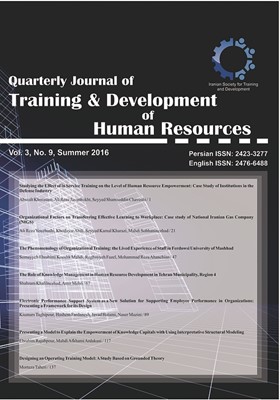-
-
List of Articles
-
Open Access Article
1 - Studying the Effect of in Service Training on the Level of Human Resource Empowerment: Case Study of Institutions in the Defense Industry
-
Open Access Article
2 - Organizational Factors on Transferring Effective Learning to Workplace: Case study of National Iranian Gas Company (NIGS)
Alireza Youzbashi Khodayar Abili -
Open Access Article
3 - The Phenomenology of Organizational Training: the lived Experience of Staff in Ferdowsi University of Mashhad
رقیه فاضل -
Open Access Article
4 - The Role of Knowledge Management in Human Resource Development in Tehran Municipality, Region 4
Shahram Khalil Nezhad -
Open Access Article
5 - Electronic Performance Support System as a New Solution for Supporting Employee Performance in Organizations: Presenting a Framework for its Design
kiumars taghipour hashem fardanesh -
Open Access Article
6 - Presenting a Model to Explain the Empowerment of Knowledge Capitals with Using Interpretative Structural Modeling
Ebrahim Rajabpour -
Open Access Article
7 - Designing an Operating Training Model: A Study Based on Grounded Theory
Morteza Taheri
-
The rights to this website are owned by the Raimag Press Management System.
Copyright © 2017-2026







